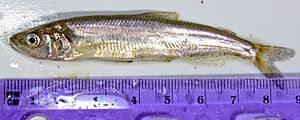Longfin smelt facts for kids
Quick facts for kids Longfin smelt |
|
|---|---|
 |
|
| Scientific classification |
The longfin smelt (Spirinchus thaleichthys) is a type of smelt fish. You can find them in many estuaries and lakes. These places are along the northern Pacific coast of North America.
Contents
What Does a Longfin Smelt Look Like?
The longfin smelt gets its name from its long pectoral fins. These fins are so long they almost reach their pelvic fins. Their sides are shiny silver. Their back can be olive green or a bit pinkish.
Body Features
Their upper jaw is long and reaches almost to the back of their eye. The lower jaw sticks out a little past the upper one. Both jaws have very tiny teeth. They also have a special line on their body called a lateral line. This line helps them sense things in the water. It only goes back as far as their dorsal fin. Longfin smelt usually grow to be about 20 centimeters (about 8 inches) long.
What Do Longfin Smelt Eat?
Longfin smelt mostly eat tiny shrimp called opossum shrimp. They also enjoy eating copepods and other small crustaceans. These are like tiny water bugs.
Who Eats Longfin Smelt?
Many different animals like to eat longfin smelt. These include other fish, birds, and even marine mammals. For example, harbor seals in the Columbia River often eat them.
Where Do Longfin Smelt Live?
Longfin smelt mostly live in the open waters of estuaries. An estuary is where a river meets the sea. They can live in both salty and fresh water. You'll usually find them in the middle or deeper parts of the water.
Places They Call Home
You can find these fish quite far north, like in Prince William Sound in Alaska. They also live in places like Skagit Bay, Grays Harbor, and Willapa Bay. Other homes include the lower Columbia River, Yaquina Bay, Coos Bay, Humboldt Bay, the Eel River estuary, Klamath River estuary, and San Francisco Bay. Sometimes, they are found near the Russian River mouth. One was even caught in Monterey Bay once.
Landlocked Populations
Some longfin smelt live in lakes that are not connected to the ocean. These are called landlocked populations. You can find them in Harrison Lake in British Columbia and Lake Washington.
Longfin Smelt Population and Protection
Longfin smelt were once very common. In the 1970s, there were many in San Francisco and Humboldt bays. But now, there are far fewer. Their numbers have dropped a lot, especially in the San Francisco Bay estuary.
Why Are Their Numbers Declining?
Scientists are not completely sure why the longfin smelt population has declined. Some ideas include changes in how much fresh water flows into estuaries. Also, water being pumped out of certain areas might affect them. Climate changes, water pollution, and new species moving into their habitats could also be reasons.
Efforts to Protect Them
Because their numbers are so low, people are working to protect them. In 1992, a group asked to list them as an endangered species. This request was not approved at first. However, by 2012, the longfin smelt was added to a list of species that might need protection under the Endangered Species Act.
They are now watched every year. Scientists check their numbers to see if they need more help. In 2015, a survey found only three longfin smelt. This was the lowest number ever recorded in those surveys.
New Discoveries
In 2020, scientists found something interesting. They discovered a group of longfin smelt living in the southern part of San Francisco Bay. These fish were spawning in marshes and sloughs. These areas get fresh water from Coyote Creek. It seems that turning old salt ponds into tidal marshes might be helping this group of fish. Also, clean recycled water from a nearby treatment plant might be supporting them. This discovery gives hope for the longfin smelt.
Froese, Rainer and Pauly, Daniel, eds. (2006). "Spirinchus thaleichthys" in FishBase. April 2006 version.
See also
 In Spanish: Spirinchus thaleichthys para niños
In Spanish: Spirinchus thaleichthys para niños

